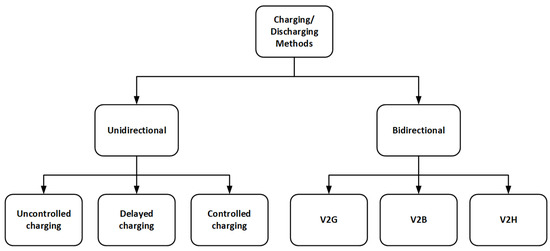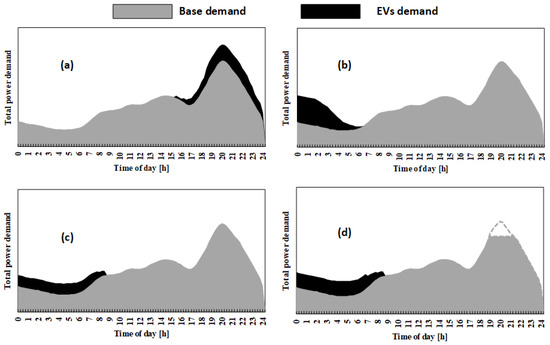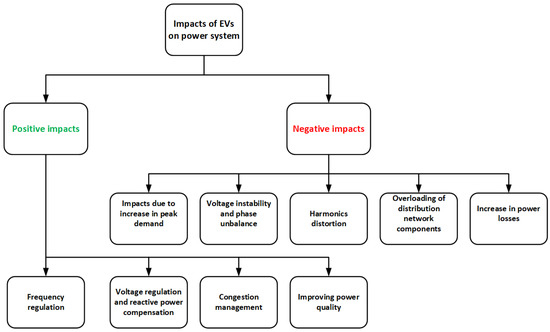1000/1000
Hot
Most Recent

There is a continuous and fast increase in electric vehicles (EVs) adoption in many countries due to the reduction of EVs prices, governments’ incentives and subsidies on EVs, the need for energy independence, and environmental issues. It is expected that EVs will dominate the private cars market in the coming years. These EVs charge their batteries from the power grid and may cause severe effects if not managed properly. On the other hand, they can provide many benefits to the power grid and get revenues for EV owners if managed properly. This article presents the potential negative impacts of EVs charging on electric power systems mainly due to uncontrolled charging and how through controlled charging and discharging those impacts can be reduced and become even positive impacts through an energy management for electric vehicles.
EVs can be charged from large charging stations, street chargers, workplace chargers, and private home chargers[1], which will be supplied from the distribution network. It is expected that this new load which draws a large amount of electric energy from the power system in a short time will have harmful effects on the distribution network if not managed optimally and will foster the need for large infrastructure upgrades, which are an economic burden for utility companies. Therefore, comprehensive studies should be executed to understand and assess the characteristics of EVs load and probable effects they may have on the electric power system, especially the distribution networks[2][3], and consider this new load in the design, operation, and planning processes. Additionally, techniques to minimize and alleviate these negative effects and for optimal integration of EVs into the power grid should be developed[4][5][6].
Charging methods can be classified into two main categories, unidirectional and bidirectional charging. In unidirectional charging the energy flow is only from the grid to EV (i.e., uncontrolled charging, delayed charging, and controlled charging)[7][8][9]. In bidirectional charging, energy can flow from the grid to EV and from EV to the grid or loads as buildings, or homes (i.e., vehicle to grid (V2G), vehicle to building (V2B), and vehicle to home (V2H)). Figure 1 presents the classification of different charging and discharging methods. Figure 2 shows how the total power demand profile of the distribution system will change with different EV charging or discharging methods[4].

Figure 1. Classification of different charging and discharging methods.

Figure 2. Total power demand profile with different charging and discharging methods. (a) Uncontrolled charging; (b) Delayed Charging; (c) Controlled Charging; and (d) V2G, V2B, and V2H.
Uncontrolled charging of EVs with high penetration levels is expected to introduce unwanted negative impacts on the power system. The possible negative impacts are the impact due to the increase of peak demand, voltage deviation from the acceptable limits, phase unbalance due to the single-phase chargers, harmonics injection, overloading of the power system equipment, and increase of power system power losses[10]. A large number of studies have investigated these impacts because the estimation of EVs charging impacts is based on several conditions and have many uncertainties that must be considered and modeled properly in the study to accurately estimate the impact of EVs charging on the power systems, the main key variables are[11][12]:
Depending on the charging infrastructure and the EV model single-phase or three-phase chargers may be used for charging. Moreover, there are many power ratings for EVs chargers operating at different voltage levels. So, the fast chargers are expected to increase the peak demand in a larger value compared with slow chargers.
The time of connecting the EVs for charging is not certain so it is unknown how many EVs may be charging at the same time and the probability that the EV charging time interferes with the peak demand time of the distribution networks. Some studies assume the charging start time of EVs, and other studies make surveys in a geographical area or a city to know the home arriving time of vehicles and model it as a probability distribution.
The place at which an EV charge is random. EV owner may charge at home, friend's home, street charger, or charging station. It may be different from the distribution network to another where are the charging locations and what are the EV charger type (i.e., private or commercial chargers).
There is a wide range of EV batteries capacity. Plug‐in Hybrid Electric Vehicle (PHEV) usually contains a small battery capacity while Battery Electric Vehicle (BEV contains a higher battery capacity. EVs with high battery capacity will draw a larger amount of energy from the power grid.
The battery SoC at the plug-in instant is stochastic. Many studies assume the SoC and others consider it as a probability distribution.
EVs still have a very small market share which will increase quickly for few countries like Norway and slowly for many other countries. Therefore, many studies considered different EVs penetration levels ranging from 10% to 100%.
There are many differences between distribution systems in terms of structure (i.e., radial or ring), equipment loading condition before connecting EVs, voltage level (i.e., medium voltage or low voltage), voltage profile, daily load profile of loads, etc.
Therefore, numerous studies were executed to assess the impacts of EVs charging on the power system. Most of the studies focus on the distribution network at which EVs charging occurs because the most severe impacts are expected to occur at the distribution level. Classification of positive and negative impacts of EVs charging/discharging on the electric power system can be seen in Figure 3.

Figure 3. Classification of EVs charging impacts on electric power systems.
EVs are parked for most of the daytime[13], and they are connected to the charger for a longer duration than the required recharging duration. Therefore, EV battery can be used to provide grid services and gain revenues for EV owners by injecting power to the grid to keep demand-supply balance or by controlling the charging time and power to reduce the charging cost and electricity bill. Many studies showed that controlled EVs charging can improve power system efficiency, reduce operation cost, and minimize RESs curtailment. Moreover, EVs controlled discharging can provide additional benefits and electrical services[14]. EVs can provide short time scale electrical services due to the fast response of battery chargers such as primary frequency control, medium time scale electrical services, such as secondary frequency control, and long time scale electrical services, such as congestion management and minimization of power losses due to the high battery capacity[15]. Figure 3 shows the positive impacts of controlled EVs charging and discharging, and the electrical services that it can provide like frequency regulation, voltage regulation and reactive power compensation, congestion management, and improving power quality.